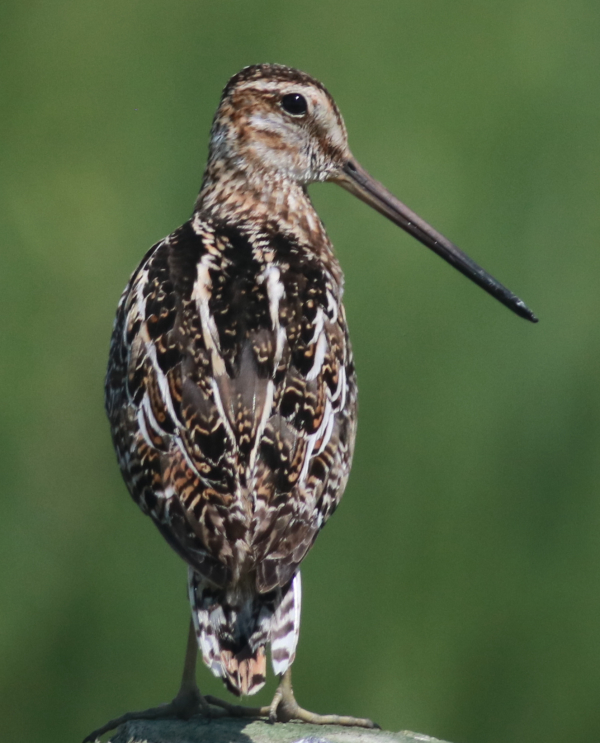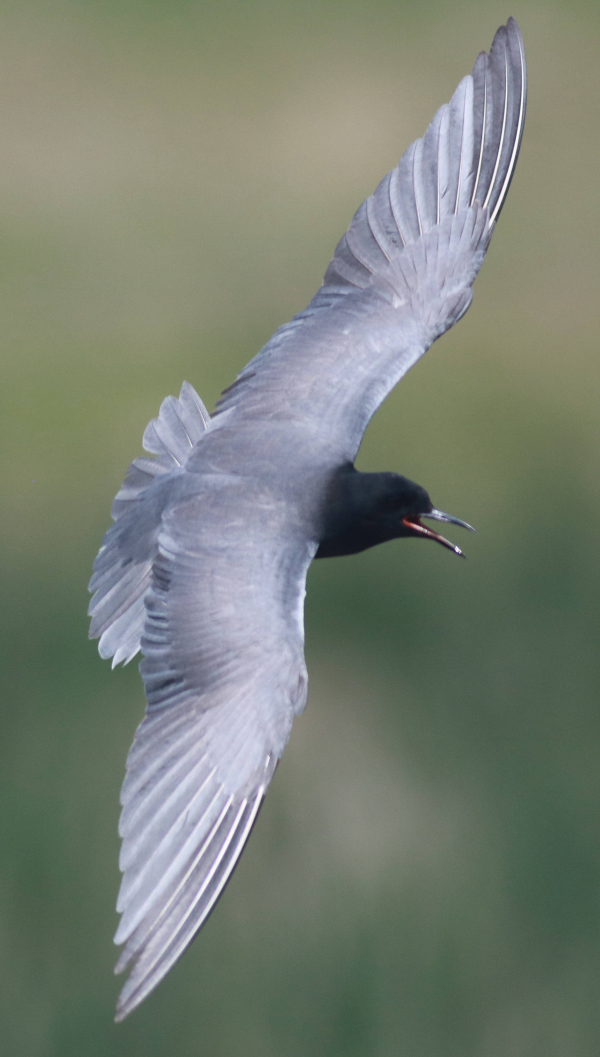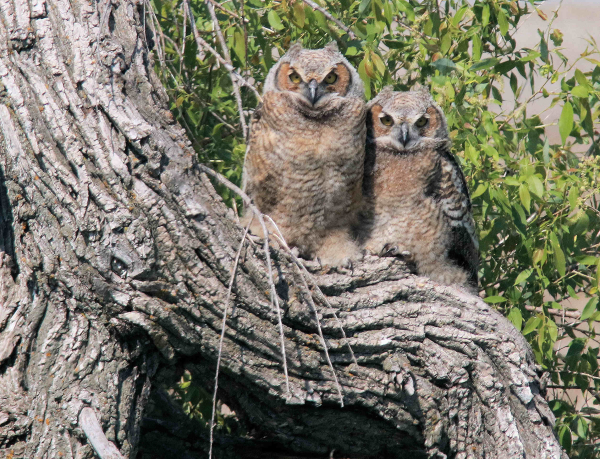
Wilson’s Snipe have been actively calling and performing flight displays in wet meadow and shallow wetland areas surrounded by native prairie during recent weeks.

Black Terns have been abundant at many area wetlands where it is possible to photograph a tern turning in flight.

Although they fledged a couple weeks ago, the young Great Horned Owls continue to stay in the same area during their post-fledging period. One day last week Paul found this tandem perched next to one another, not unlike how they stood in their nest before fledging.
|
A quick trip to Minnesota always provides sightings of a variety of different birds from the eastern woodlands and lake habitats – different from the many birds I see in the Great Plains. I was especially excited to see a brood of 10 newly hatched ducklings encircling a female Wood Duck as they instinctively fed in the shallows, along with a Common Loon resting on calm water, a Peregrine Falcon and Red-tailed Hawk taking turns diving at one another, a Cooper’s Hawk with prey flying to its nest, colorful pairs of Northern Cardinals, periodic Ospreys in flight, and a seemingly huge Pileated Woodpecker flying overhead. No photo opportunities though; until the morning after my return to Dakota.
You never know what birds, if any, will offer an interesting sighting or photo ops, but Friday morning, back in my neighborhood, I appreciated the chances I had to photograph Black Terns, perched and in flight, a Wilson’s Snipe standing and calling territorially, flight displays and songs of Bobolinks that provided a pulse of sound across the prairie, and male Orchard Orioles seemed to be in every stand of trees that peppered the plains.
Feeder Surprises
Friday I also noticed that an immature or female Ruby-throated Hummingbird found my nectar feeder after a couple weeks of inactivity – hooray; but my oriole action was waning throughout the week – booo. It appears I’m down to three male orioles visiting my grape jelly feeder; a male Baltimore, an adult male Orchard, and a yearling Orchard. Actually, House Finches are more common at my oriole feeder. Sunday, two hummingbirds “collided” at my feeder, both probably young birds. It’s interesting to note that the orioles taste for oranges appears to have subsided a week or so ago; that’s to be expected considering past experience.
Yard birds are dominated by lots of fledgling robins and grackles, especially robins; they are such beautiful and enjoyable fledglings to have near. Other regular yard visitors include Eastern and Western Kingbirds, Barn Swallows, and Chimney Swifts that ply the airways, while Chipping Sparrows are more ground-oriented and add their songs to the local mix.
Nesting Owl and Raptor Updates
All Great Horned Owls have fledged now, but I only find the two fledglings from the former Ferruginous Hawk nest regularly. They can fly fine, although they still have plenty of fluffy feathers that makes them look like cute little owls, despite their size. I imagine they are starting to try to hunt by now, although probably during hours of darkness. The adults are still in close contact and are certainly providing a healthy diet for the still growing and developing fledglings.
The hawks must all have downy nestlings now, although I haven’t seen any heads emerge above the rim of any nests yet. I’m tempted to try to climb the hill to check the status at the Ferruginous Hawk nest, but I prefer not to for a number of reasons; most notably because this pair has always been so trusting of me and I’m fearful of how they would react if I approached close to their nest for a quick look. I’ve checked hundreds of Ferruginous Hawk nests as a professional biologist, so I probably wouldn’t see anything different; but I could gain some insights about the number of nestlings, their age, and it would be interesting to see what prey remains I might find.
While I observe the Ferrugs from a distance, it’s a new thrill to check on the Bald Eagle nest periodically. When I visited the nest Sunday morning, the growing nestlings were rather subdued – until one of the adults flew to the nest, flaring its wings and tail broadly as it landed. The young eagles definitely became aroused and approached the adult, but I didn’t see any evidence that the adult brought food, or that the nestling were feeding after adult took a quick circle flight to perch on one of the large branches adjacent to the nest. I decided that I might be a cause for concern, or at least my van might have been, so after checking the area for the other adult, I decided to move along. While observing the nest, I saw one of the nestlings, perhaps the middle-sized one of the three, stretch its wings above its back; thereby revealing that it could be ready to test its wings in a couple weeks – around the 4th of July perhaps; that would be fitting.
The Drift Plain
The eagle nest is east of my usual birding drives on the eastern edge of the Missouri Coteau. The area where the eagles have settled is within another geologic sub-region known as the Drift Plain. While the Coteau is hilly with an abundance of non-integrated wetlands, the drift plain is quite level and its prairie has mostly been converted to fertile farmlands with more tree plantings and shelterbelts dividing the fields. I share this description because I have been seeing a couple bird species on the Drift Plain that I’m not seeing in the Coteau this year, namely Red-headed Woodpeckers and Dickcissels. Red-headed Woodpeckers are a favorite of mine, and they do venture west of the Drift Plain, but these birds underline the difference between the two areas and my need to spend a little more time in the Drift Plain. I’ll keep you posted.
Article and photos by Paul Konrad
Share your bird sightings and photos at editorstbw2@gmail.com